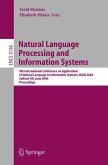Ontologies have been developed and investigated for some time in artificial intelligence to facilitate knowledge sharing and reuse. More recently, the notion of ontologies has attracted attention from fields such as databases, intelligent information integration, cooperative information systems, information retrieval, electronic commerce, enterprise application integration, and knowledge management. This broadened interest in ontologies is based on the feature that they provide a machine-processable semantics of information sources that can be communicated among agents as well as between software artifacts and humans. This feature makes ontologies the backbone technology of the next web generation, i.e., the Semantic Web. Ontologies are currently applied in areas such as knowledge management in large company-wide networks and call centers, and in B2C, B2G, and B2B electronic commerce. In a nutshell, ontologies enable effective and efficient access to heterogeneous and distributed information sources. Given the increasing amount of information available online, this kind of support is becoming more important day by day.
The author systematically introduces the notion of ontologies to the non-expert reader and demonstrates in detail how to apply this conceptual framework for improved intranet retrieval of corporate information and knowledge and for enhanced Internet-based electronic commerce. He also describes ontology languages (XML, RDF, and OWL) and ontology tools, and the application of ontologies.
In addition to structural improvements, the second edition covers recent developments relating to the Semantic Web, and emerging web-based standard languages.
___________
The author systematically introduces the notion of ontologies to the non-expert reader and demonstrates in detail how to apply this conceptual framework for improved intranet retrieval of corporate information and knowledge and for enhanced Internet-based electronic commerce. He also describes ontology languages (XML, RDF, and OWL) and ontology tools, and the application of ontologies.
In addition to structural improvements, the second edition covers recent developments relating to the Semantic Web, and emerging web-based standard languages.
___________
From the reviews of the second edition: "This book provides an excellent introduction to ontologies. ... It has many examples illustrating to the reader the different characteristics of ontologies ... . One of the strengths of the book is that it is presented in the context of the semantic web ... . The book is a good blend of theory, applications and illustrations of ontologies. ... provides depth and insight into key problems of ontologies. ... provides the reader with a large number of references. ... Many of the references are new ... . To summarize, this is an excellent book ... ." (Daniel O'Leary, The Computer Journal, Vol. 48 (4), 2005)









